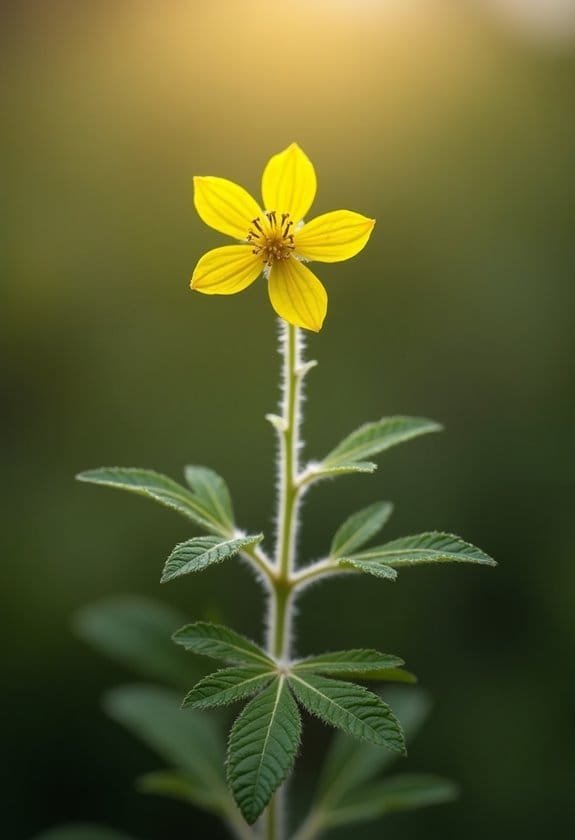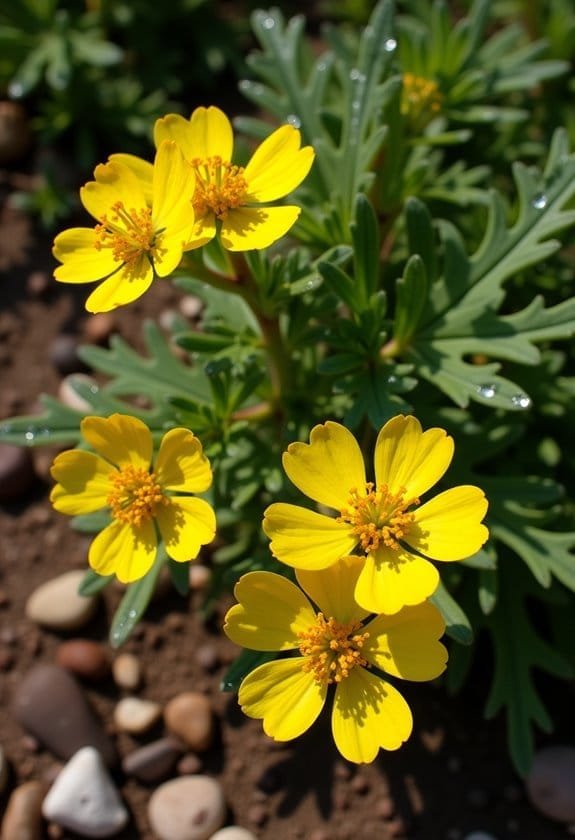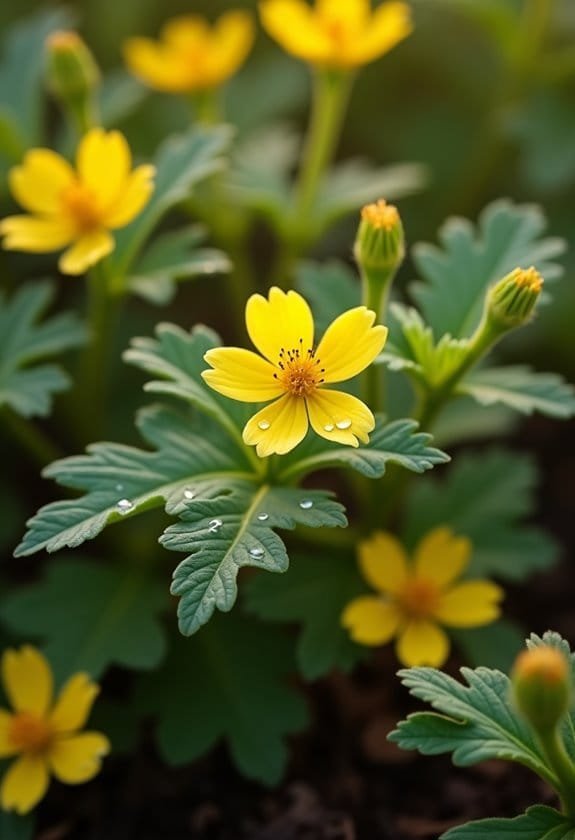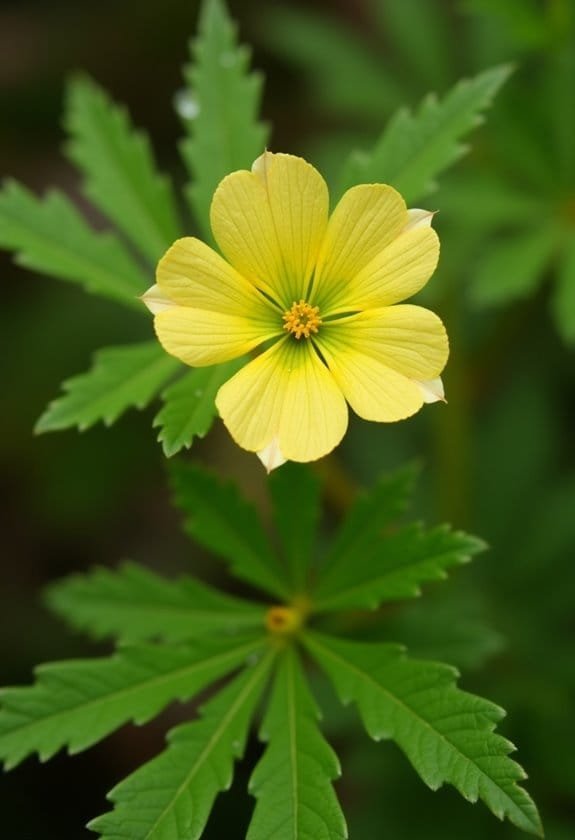Potentilla species, commonly called cinquefoil, are versatile flowering plants in the rose family that feature distinctive five-petaled blooms in yellow, white, pink, or red hues. These hardy perennials, ranging from 2 to 20 inches tall, thrive in full sun and well-draining soil across USDA zones 2-7. Their palmately compound leaves sport 3 to 15+ sharp-toothed leaflets, while their open-faced flowers attract diverse pollinators throughout the growing season. As reliable ground covers and border plants, cinquefoils serve essential ecological roles by supporting local biodiversity and controlling erosion. Their robust nature and adaptable growth habits make them increasingly valuable for sustainable landscaping solutions.
Main Points
- Potentilla (Cinquefoil) is a genus of over 500 species featuring five-petaled flowers in yellow, white, pink, or red colors.
- These plants thrive in full sun with well-draining soil, growing 2-20 inches tall with compound leaves containing 3-15 leaflets.
- Flowers bloom from late spring through early fall, providing essential nectar for pollinators like bees, butterflies, and hoverflies.
- The name "cinquefoil" means "five leaves," though leaflet numbers vary among species, helping with plant identification.
- Plants are hardy across USDA zones 2-7 and effective for ground cover, borders, and erosion control in gardens.
Introduction

Potentilla species, commonly known as cinquefoils, represent a diverse genus of flowering plants comprising more than 500 distinct species in the rose family Rosaceae.
These resilient plants have earned recognition for their characteristic five-petaled blooms, which typically emerge in vibrant yellow hues but can also display white, pink, or red variations.
Found across cool temperate regions worldwide, Potentilla species have established themselves as valuable ornamental plants in gardens while simultaneously playing essential roles in traditional medicine and soil stabilization.
Common Name
Among the most common names for Potentilla species, "cinquefoil" stands prominently, derived from Latin words meaning "five leaves" – a reference to the plant's distinctive five-leaflet structure. This nomenclature accurately reflects the plant's most recognizable characteristic, making it an apt descriptor for these diverse flowering plants that have become well-established across cool and cold regions worldwide.
While "cinquefoil" remains the predominant common name, these plants have acquired various regional and descriptive monikers throughout their range. The term "barren strawberry" has emerged as a particularly interesting alternative name, highlighting the visual similarity these plants share with true strawberries, despite producing inedible fruits.
Among the numerous species, Common tormentil (Potentilla erecta) has garnered significant recognition, both for its ecological importance and historical medicinal applications. The naming conventions for Potentilla species often reflect their growth habits, flower colors – which range from characteristic yellow to less common white, pink, and red hues – or their historical uses in traditional medicine and folklore.
Scientific Name
The scientific name Potentilla encompasses more than 500 species within the Rosaceae family, tracing its origins to Carl Linnaeus's foundational taxonomic work in 1753. When establishing the genus, Linnaeus designated Potentilla reptans, commonly known as European cinquefoil, as the type species, setting a taxonomic standard that continues to guide botanical classification today.
The name Potentilla itself carries significant meaning, derived from Latin roots that translate to "little powerful," an apt description that acknowledges the medicinal properties historically attributed to various cinquefoil species.
This genus, positioned within the subfamily Rosoideae, shares notable genetic and morphological similarities with its close relatives, including the genera Geum and Rosa.
The scientific classification reflects the remarkable diversity within Potentilla, accounting for species that display an impressive array of morphological variations. These distinctions manifest in different leaf arrangements and flower colorations, ranging from vibrant yellows to pristine whites, and from delicate pink hues to rich reds, all while maintaining the characteristic features that define the genus.
Overview
Comprising more than 500 diverse species, cinquefoils (Potentilla) are versatile herbaceous flowering plants that have adapted to cool and cold regions worldwide. These remarkable plants showcase distinctive five-petaled blooms in various hues, including yellow, white, pinkish, and red, with each flower typically measuring about one inch in diameter.
Potentilla species have established themselves as significant contributors to ecological systems, forming intricate relationships with local wildlife. Their flowers serve as essential nectar sources for numerous pollinators, while their foliage provides sustenance for specific butterfly larvae.
The plants' compound leaves and spreading growth patterns make them particularly effective for erosion control in challenging landscapes.
In cultivation, these adaptable plants have gained recognition for their ornamental value and practical applications in garden design. Their preference for well-drained soil and full sun exposure makes them ideal candidates for various landscape settings, from rock gardens to border plantings.
The genus's widespread distribution and environmental adaptability have contributed to its success in both natural habitats and cultivated environments.
Key Features
Potentilla species range from low-growing perennials barely reaching 1 foot in height to spreading shrubs forming extensive patches through their rooting stems.
The plants display distinctive palmately compound leaves with 3 to 15+ sharp-toothed leaflets, creating a characteristic fan-like arrangement that gives many species their common name "cinquefoil."
Their bright yellow flowers, measuring approximately 1 inch across, feature five heart-shaped petals surrounding a cluster of yellow stamens that often change to reddish hues as they mature.
Growth Size
Modest in stature, these versatile plants range from 2 to 20 inches in height, making them ideal candidates for garden borders and mixed plantings. The growth habit of these adaptable perennials varies markedly among species, with common cinquefoil (P. erecta) demonstrating a particularly compact form rarely exceeding 12 inches.
Their dimensional characteristics perfectly complement their vigorous growth pattern, as most varieties exhibit robust development during the spring and summer growing seasons. The plants' ability to reroot at leaf nodes enables them to create expansive, dense patches that serve as excellent ground cover options.
This spreading tendency, combined with their moderate height, makes them particularly effective in filling garden spaces without overwhelming neighboring plants.
When provided with their preferred conditions of well-drained, organic-rich soil and full sun exposure, Potentilla species maintain their characteristic size while developing a fuller, more robust form.
Their distinctive palmately compound leaves, typically arranged in groups of five, contribute to their compact yet intricate appearance, creating an aesthetically pleasing display at their modest height.
Appearance
Adorning gardens with their delicate charm, cinquefoil plants display distinctive five-petaled flowers in hues ranging from sunny yellow to pristine white, soft pink, and rich red. These enchanting blooms, measuring approximately one inch in diameter, create a tapestry of color across their growing area, while their appearance evolves subtly throughout the growing season.
The most striking part of the plant's appearance lies in its palmately compound leaves, which typically cluster in groups of five, reminiscent of delicate green fans spreading outward from central points. Each leaflet features prominent serrated edges with sharp-pointed teeth, creating an intricate pattern that distinguishes cinquefoils from similar species.
The stems contribute to the plant's visual appeal, shifting from vibrant green to deeper reddish hues as they mature, often displaying varying degrees of hairiness along their length. As the plants spread and establish themselves, they create dense, carpet-like patches through their ability to root at leaf nodes.
Species identification often relies on subtle variations in sepal length, specific leaf arrangements, and the abundance of flowers produced by individual plants.
Flowering Season
Nature's timekeepers, these resilient plants burst into bloom from late spring through early fall, with peak flowering occurring during the summer months. During this extended flowering season, Potentilla species showcase their distinctive five-petaled blossoms, which primarily display vibrant yellow hues but can also appear in elegant shades of white, pink, and red.
Each delicate flower measures approximately one inch in diameter, featuring an array of stamens that transform into striking reddish tones as they mature. While the precise timing of blooms may fluctuate depending on environmental conditions and specific varieties, many Potentilla species maintain their floral display throughout the growing season.
The plants' ability to produce multiple flowers simultaneously enhances their ornamental value, creating sweeping patches of color in both cultivated gardens and natural landscapes. This prolonged flowering period, coupled with the plants' prolific blooming habit, makes Potentilla species particularly valuable for seasonal garden planning and naturalized settings where extended visual interest is desired.
Environmental factors such as temperature, moisture levels, and day length can influence the intensity and duration of flowering.
Growing Requirements

Potentilla species require specific growing conditions to flourish in gardens and landscapes across diverse climate zones.
These hardy plants thrive in full sun exposure but demonstrate remarkable adaptability by tolerating partial shade, making them versatile choices for various garden locations.
Their success depends on well-draining, nutrient-rich soil combined with consistent moisture levels during the growing season, while their temperature tolerance spans from the frigid conditions of zone 2 to the moderate climates of zone 7.
Light
These sun-loving perennials require abundant light to reach their full capabilities. Potentilla species flourish when exposed to direct sunlight throughout the growing season, which promotes vigorous growth and maximizes their flowering capacity. The plants harness solar energy most effectively when positioned in locations that receive six or more hours of unfiltered sunlight daily.
While most Potentilla varieties demonstrate excellent performance in full sun conditions, some cultivars exhibit a surprising degree of adaptability to partially shaded environments. In areas where dappled shade occurs, particularly during afternoon hours, certain species can maintain satisfactory growth patterns, though flowering may be somewhat reduced.
The relationship between light exposure and plant vigor becomes especially apparent in their bloom production, as insufficient light often results in diminished flowering and potentially leggy growth habits. Gardeners should carefully evaluate their landscape's light patterns when selecting planting locations, keeping in mind that morning sun exposure typically proves more beneficial than afternoon light, which can sometimes be too intense in particularly hot climates.
Soil
For ideal growth and development, Potentilla species require well-drained soil rich in organic matter. These adaptable plants thrive when their root systems can establish themselves in soil that effectively manages moisture levels, preventing the detrimental effects of waterlogging that could lead to root rot.
The best soil composition for Potentilla cultivation maintains a delicate balance between moisture retention and drainage, with a pH range slightly on the acidic to neutral spectrum. This specific pH environment facilitates efficient nutrient uptake, enabling the plants to access essential minerals for robust growth and prolific flowering.
Regular incorporation of organic amendments, particularly well-decomposed compost, proves instrumental in maintaining soil fertility and structure.
While Potentilla species demonstrate remarkable adaptability to various soil conditions, their performance peaks in environments where organic matter content is consistently replenished.
Gardeners can enhance their soil's characteristics by implementing annual compost applications, which not only improve structure but also provide a steady supply of nutrients, creating an environment where these versatile plants can flourish throughout their growing season.
Water
Maintaining proper moisture levels is vital for Potentilla species, as they require consistent but moderate watering throughout their growing season. These adaptable plants demonstrate a delicate balance in their water requirements, thriving when soil moisture remains steady without becoming waterlogged. Regular monitoring and thoughtful irrigation practices help guarantee ideal growth conditions for these versatile perennials.
While Potentilla species appreciate consistent moisture, they're particularly sensitive to overwatering, which can lead to detrimental root rot and compromise the plant's overall health.
In areas with dappled shade, water requirements may need adjustment, as reduced sunlight exposure typically results in slower soil moisture evaporation. Implementing a layer of organic mulch around the plants serves as an effective moisture-retention strategy, creating a natural barrier that helps maintain consistent soil hydration levels while reducing the frequency of necessary watering.
During extended dry periods, supplemental watering becomes essential, though gardeners should always verify the soil drains efficiently to prevent water accumulation around the root system, which could potentially harm these otherwise resilient plants.
Temperature
Temperature needs complement the moisture requirements of Potentilla species, with these hardy plants demonstrating remarkable adaptability across USDA hardiness zones 2-7. This impressive temperature tolerance allows Potentilla to thrive in regions experiencing winter temperatures as low as -50°F (-45.5°C), making them exceptionally versatile for cold climate gardening.
During the growing season, Potentilla exhibits ideal growth when daytime temperatures range between 65-75°F (18-24°C), though they can withstand considerably higher temperatures when properly maintained. The plants' temperature resilience is particularly evident in their ability to maintain active growth throughout summer months, even during periods of moderate heat stress.
Like hardy sentinels in the garden, they continue flowering while other plants may struggle with temperature fluctuations.
For best results in warmer zones, providing afternoon shade can help moderate temperature exposure, especially in regions approaching the upper limits of their hardiness range. This temperature adaptability, combined with their seasonal growth patterns, enables Potentilla to establish robust root systems during spring's moderate temperatures and maintain steady growth through summer's warmth.
Pollinator Criteria
Potentilla species serve as essential pollinator magnets in gardens and natural landscapes, attracting a diverse array of beneficial insects through their abundant nectar production and prominent yellow-stamened blooms.
The flowers' open-faced structure makes them particularly accessible to short-tongued pollinators like hover flies and various bee species, which facilitate effective cross-pollination between plants.
These beneficial relationships contribute considerably to local ecosystem health, as visiting pollinators help maintain genetic diversity while simultaneously supporting insect populations, including specialized caterpillar species that depend on Potentilla as a food source.
Attracted Pollinators
Buzzing with activity, the abundant nectar-rich flowers of Potentilla species draw in diverse pollinators, including bees, hoverflies, and ants. Their mainly yellow blooms serve as natural beacons, enhancing visibility and attracting a wide array of beneficial insects to their nutritious offerings.
The ecological significance of Potentilla extends beyond mere attraction, as these plants form essential relationships with specific insect species. For instance, the Polish cochineal (Porphyrophora polonica) demonstrates a distinctive dependency on Potentilla for its survival, highlighting the plant's role in supporting specialized ecological niches.
Common tormentil (P. erecta), with its vibrant yellow flowers, proves particularly attractive to adult butterflies and moths seeking nectar resources.
In garden settings, Potentilla species function as biodiversity hubs, creating micro-ecosystems that support various pollinator populations. Their consistent nectar production throughout the flowering season guarantees a reliable food source for multiple insect species, contributing to the overall health and stability of local ecosystems.
This sustained support of pollinator communities makes Potentilla an invaluable component of both natural and cultivated landscapes.
Pollination Method
The process of pollination in Potentilla species relies mainly on insect-mediated transfer, with flowers exhibiting specific adaptations to attract suitable pollinators. These adaptations include an accessible flower structure and abundant nectar production, which effectively draws various insects, particularly bees and hoverflies.
The plants employ a sophisticated signaling system through their stamens, which undergo a remarkable transformation from yellow to red as they age. This color change serves as a visual indicator to visiting insects, directing them toward flowers at their ideal nectar-producing stage.
The multiple flowers present on each plant create an efficient pollination strategy, considerably increasing the probability of successful reproduction through cross-pollination.
The ecological significance of Potentilla's pollination method extends beyond basic reproduction, as evidenced by species-specific relationships like that of the Polish cochineal. The plant's role in supporting local biodiversity becomes particularly apparent through its intricate pollination mechanisms, which have evolved to guarantee both the survival of the plant species and their dependent insect populations.
This mutual relationship demonstrates the refined nature of plant-pollinator interactions in maintaining ecosystem balance.
Care & Maintenance

Successful cultivation of Potentilla species begins with proper planting in well-draining soil and regular maintenance throughout the growing season.
Gardeners should establish a consistent watering schedule, particularly during dry spells, while incorporating light pruning in late winter to encourage robust flowering and applying a balanced fertilizer to enhance growth.
These hardy plants benefit from strategic pairing with complementary perennials like Salvia and Geranium species, which share similar growing requirements and create visually appealing garden combinations.
Planting Tips
Growing healthy Potentilla plants consistently requires attention to key maintenance practices. When selecting a planting location, gardeners should prioritize areas that receive abundant sunlight throughout the day, though these adaptable plants can manage with partial shade in warmer climates.
For ideal growth, prepare the planting site by incorporating organic matter into well-draining soil, creating an environment that supports robust root development. The planting hole should be twice the width of the root ball, allowing roots to establish themselves effectively in their new location.
Once the plant is positioned, apply a 2-3 inch layer of mulch around the base, being careful to keep it away from the stem to prevent rot. Initial watering is essential for establishment, so thoroughly soak the soil immediately after planting.
During the first growing season, maintain consistent moisture levels without waterlogging the soil. Space multiple plants approximately 2-3 feet apart to accommodate their mature spread and guarantee adequate air circulation, which helps prevent fungal issues.
In regions with harsh winters, planting in spring gives roots time to establish before cold weather arrives.
Ongoing Care
Maintaining Potentilla species requires consistent attention to several key care practices throughout the growing season. Regular watering forms the cornerstone of ongoing care, particularly during periods of drought when these resilient plants need supplemental moisture to sustain their flowering performance.
In late winter or early spring, light pruning becomes essential for managing the plant's structure and encouraging robust new growth, which will ultimately support the season's floral display.
Gardeners should complement these efforts by applying a layer of protective mulch around the plant's base, creating a moisture-retaining barrier that simultaneously suppresses unwanted weed growth and enhances soil conditions. For ideal results, incorporating a balanced fertilizer into the care routine can considerably boost both vegetative growth and flowering potential.
Taller varieties of Potentilla may require additional support structures to prevent their flowering stems from bending under their own weight.
This supportive framework, when installed early in the growing season, guarantees the plants maintain their natural, upright form while showcasing their blooms to maximum effect throughout their display period.
Suggested Companions
When planning a garden with Potentilla species, selecting compatible companion plants enhances both aesthetic appeal and overall garden health. The well-draining, organic-rich soil requirements of Potentilla make it an ideal partner for drought-tolerant plants like lavender and sedum, creating a harmonious ecosystem of similar needs.
In partially shaded areas, Potentilla's adaptability allows for successful pairing with shade-tolerant herbaceous perennials such as hostas and ferns, which thrive in dappled light conditions.
The plant's regular watering needs align perfectly with moisture-loving companions like daylilies, ensuring a consistent watering schedule benefits multiple species simultaneously. Their maintenance schedules also complement other perennials, as both Potentilla and plants like coneflowers benefit from late winter pruning to maintain their form and vigor.
To maximize the garden's ecological value, combining Potentilla with pollinator-friendly species such as bee balm and echinacea creates a vibrant sanctuary for beneficial insects. This thoughtful companionship not only enhances the garden's visual appeal but also promotes a balanced and sustainable environment where diverse species can flourish together.
Common Issues
Potentilla species face several common challenges, including leaf spot diseases caused by fungi and infestations of spider mites that can damage foliage during warm, dry conditions.
Root rot poses a significant threat when plants are grown in poorly draining soils, while powdery mildew often appears as a white coating on leaves during periods of high humidity.
Regular inspection, proper spacing for air circulation, and maintaining appropriate soil moisture levels can help prevent most issues, though severe cases may require targeted fungicides or organic pest control methods.
Pests/Diseases
Though generally hardy, these plants can run into several pest and disease issues that gardeners should monitor.
Aphids pose a considerable threat to Potentilla species, causing leaves to curl and distort, which can impact the plant's overall appearance and vigor. In humid conditions, fungal infections like powdery mildew and leaf spot can establish themselves, creating unsightly patches on the foliage and potentially weakening the plant's health.
Root rot presents perhaps the most serious challenge, particularly in poorly draining soils where excess moisture creates ideal conditions for pathogenic fungi to thrive.
While caterpillars from various Lepidoptera species may feast on Potentilla's foliage, their feeding typically doesn't cause lasting damage to these resilient plants.
To maintain healthy specimens, gardeners should implement a thorough monitoring strategy that includes regular inspection of leaves, stems, and soil conditions. Ensuring proper air circulation by appropriate spacing between plants, maintaining well-draining soil conditions, and promptly addressing any signs of pest infestation or disease can greatly reduce the likelihood of serious problems developing.
Solutions
For successful cultivation of Potentilla species, addressing common issues starts with proper identification. Careful observation of leaflet count and surface texture helps distinguish between similar species, with P. simplex featuring five leaflets while P. anglica displays four leaflets with glabrous blades. According to Plant Trust guidelines, accurate identification guarantees appropriate care protocols.
Managing soil conditions plays an essential role in preventing root-related problems. Installing proper drainage systems and incorporating organic matter into the soil creates an ideal growing environment, preventing the detrimental effects of waterlogging.
Gardeners should establish a balanced watering schedule, providing moisture during dry spells while avoiding oversaturation that can compromise root health.
Regular maintenance through strategic pruning in late winter or early spring helps control the plant's spreading habit and promotes healthy growth patterns.
When trimming, remove overcrowded stems and dead foliage to improve air circulation and reduce disease susceptibility. This approach, combined with careful monitoring of soil moisture levels, creates favorable conditions for robust flowering and sustained plant importance throughout the growing season.
Summary

Comprising over 500 species of herbaceous flowering plants, the genus Potentilla showcases distinctive five-petaled blooms and palmately compound leaves across cool and cold regions worldwide.
These resilient plants, commonly known as cinquefoils, have adapted to diverse ecosystems where they contribute considerably to local biodiversity and ecological stability.
The versatility of Potentilla species extends beyond their natural habitats into practical applications. Common tormentil (Potentilla erecta) has earned recognition in traditional medicine for its anti-inflammatory and digestive properties, while ornamental varieties like golden cinquefoil and ruby cinquefoil enhance gardens with their vibrant displays.
Their ability to attract pollinators makes them valuable additions to any landscape design.
These adaptable plants demonstrate remarkable environmental flexibility, thriving in well-drained soils under full sun exposure.
Their robust nature makes them excellent candidates for erosion control and sustainable landscaping projects.
As climate patterns continue to shift, Potentilla species' resilience and wide-ranging applications position them as increasingly important plants for both ecological conservation and human utilization.


